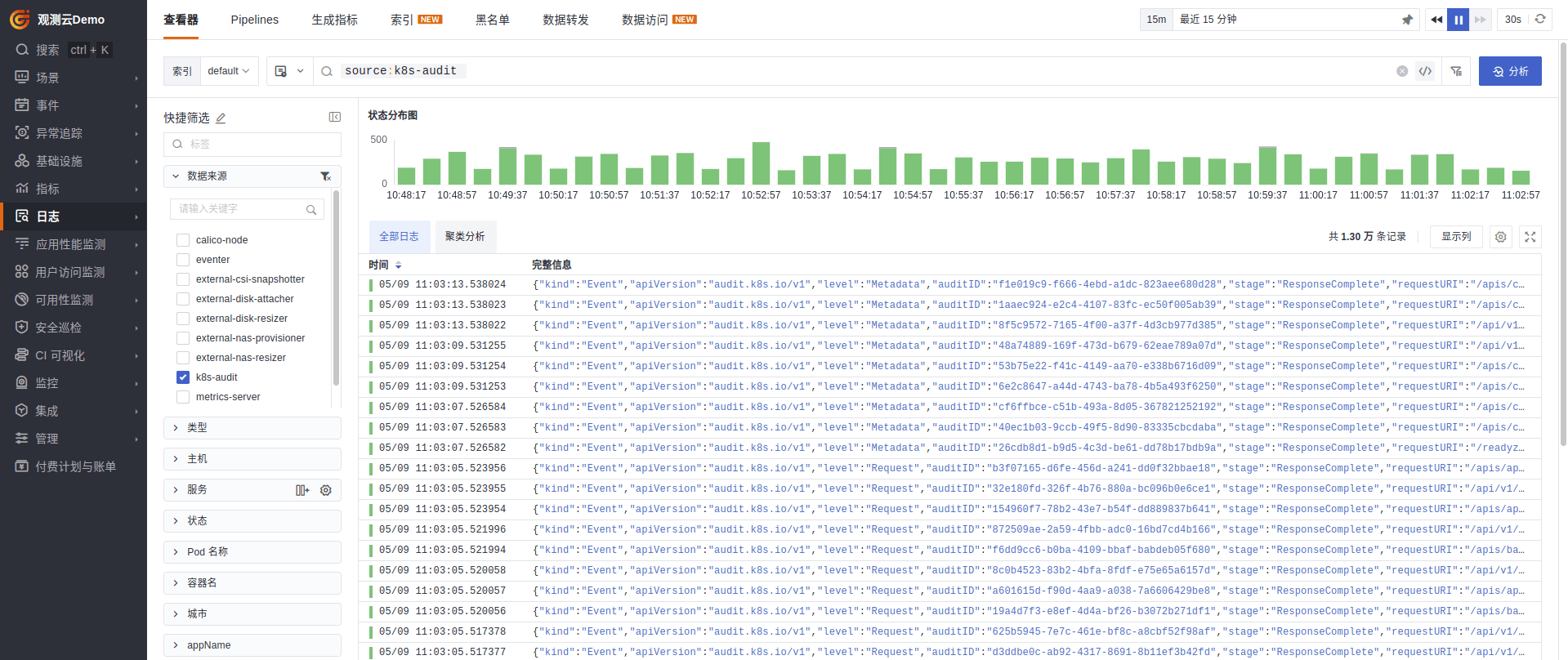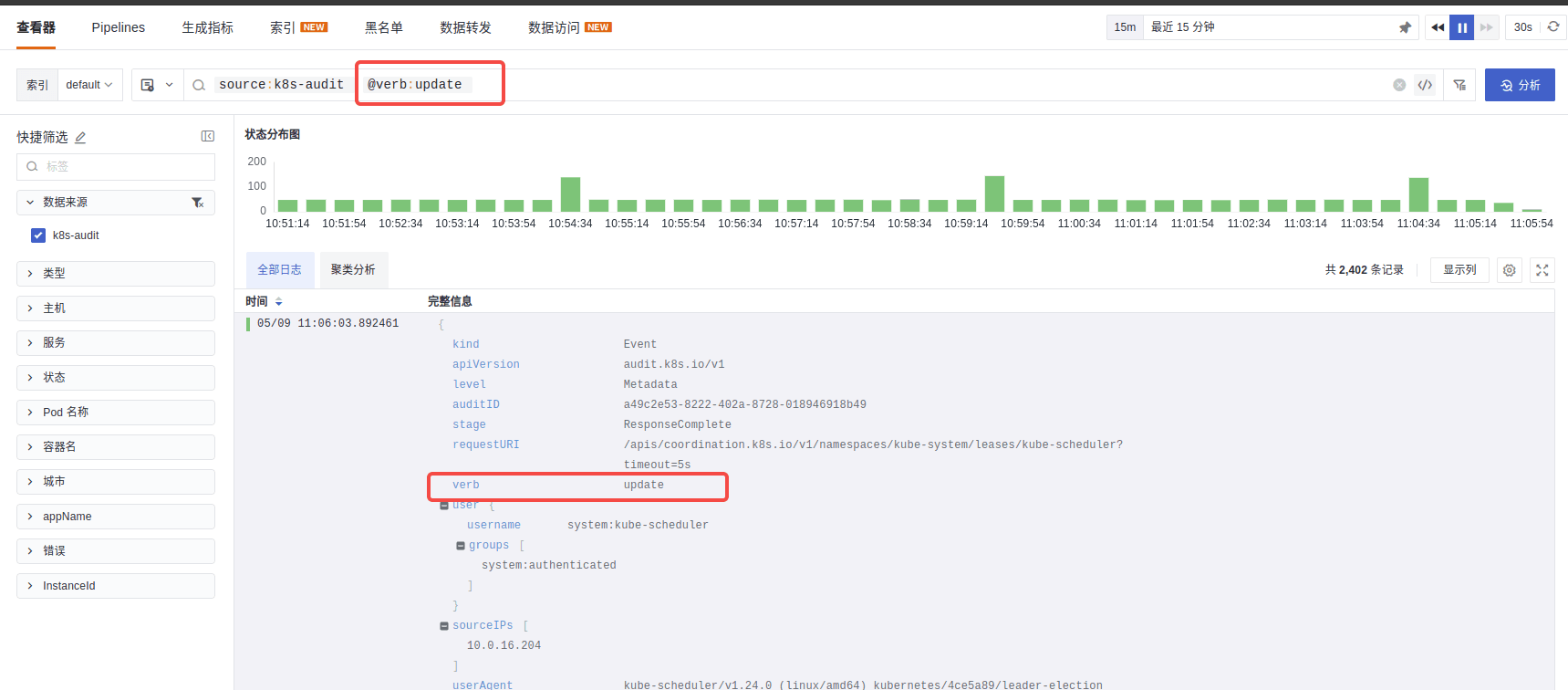Kubernetes 审计日志概述
Kubernetes 在 1.7 版本中发布了审计(Audit)日志功能,审计(Audit)提供了安全相关的时序操作记录(包括时间、来源、操作结果、发起操作的用户、操作的资源以及请求/响应的详细信息等),通过审计日志,我们能够非常清晰的知道 K8S 集群到底发生了什么事情,包括但不限于:
当前/历史上集群发生了哪些变更事件。
这些变更操作者是谁,是系统组件还是用户,是哪个系统组件/用户。
重要变更事件的详细内容是什么,比如修改了 POD 中的哪个参数。
事件的结果是什么,成功还是失败。
操作用户来自哪里,集群内还是集群外。
审计日志格式
Kubernetes 审计日志是以 json 格式的方式进行输出的,如下所示:
{ "kind": "Event", "apiVersion": "audit.k8s.io/v1", "level": "Metadata", "auditID": "432064d5-bda6-4957-a9e8-369f364e5748", "stage": "ResponseComplete", "requestURI": "/api/v1/namespaces/tigera-operator/configmaps/operator-lock", "verb": "update", "user": { "username": "system:serviceaccount:tigera-operator:tigera-operator", "uid": "8ab017b1-c57d-4aa4-a52f-5acec0c1e72e", "groups": ["system:serviceaccounts", "system:serviceaccounts:tigera-operator", "system:authenticated"], "extra": { "authentication.kubernetes.io/pod-name": ["tigera-operator-d7957f5cc-hv5p8"], "authentication.kubernetes.io/pod-uid": ["2e859424-41ca-4f64-a1c6-b0ae3395e480"] } }, "sourceIPs": ["10.0.16.202"], "userAgent": "operator/v0.0.0 (linux/amd64) kubernetes/$Format/leader-election", "objectRef": { "resource": "configmaps", "namespace": "tigera-operator", "name": "operator-lock", "uid": "5f5b044f-9d7e-4c89-b703-f85affe91a25", "apiVersion": "v1", "resourceVersion": "13338825" }, "responseStatus": { "metadata": {}, "code": 200 }, "requestReceivedTimestamp": "2024-05-09T01:51:24.165036Z", "stageTimestamp": "2024-05-09T01:51:24.167660Z", "annotations": { "authorization.k8s.io/decision": "allow", "authorization.k8s.io/reason": "RBAC: allowed by ClusterRoleBinding \"tigera-operator\" of ClusterRole \"tigera-operator\" to ServiceAccount \"tigera-operator/tigera-operator\"" }}
复制代码
审计日志阶段
审计日志根据日志策略可以选择在事件执行的某个阶段记录,目前支持的事件阶段有:
RequestReceived 接收到事件且在分配给对应 handler 前记录。
ResponseStarted 开始响应数据的 Header 但在响应数据 Body 发送前记录,这种一般应用在持续很长的操作事件,例如 watch 操作。
ResponseComplete 事件响应完毕后记录。
Panic 内部出现 panic 时记录。
审计日志等级
审计日志根据日志策略可以选择事件保存的等级,根据等级不同,APIServer 记录日志的详细程度也不同。目前支持的事件等级有:
None 不记录日志。
Metadata 只记录 Request 的一些 metadata (例如 user, timestamp, resource, verb 等),但不记录 Request 或 Response 的 body。
Request 记录 Request 的 metadata 和 body。
RequestResponse 最全记录方式,会记录所有的 metadata、Request 和 Response 的 Body。
审计日志策略
APIServer 支持对每类不同的资源设置不同的审计日志策略,包括日志记录阶段以及日志记录等级,目前官方以及很多云厂商都会提供日志策略,一般都遵循以下原则:
在收到请求后不立即记录日志,当返回体 header 发送后才开始记录。
对于大量冗余的 kube-proxy watch 请求,kubelet 和 system:nodes 对于 node 的 get 请求,kube 组件在 kube-system 下对于 endpoint 的操作,以及 apiserver 对于 namespaces 的 get 请求等不作审计。
对于 /healthz,/version,/swagger* 等只读 url 不作审计。
对于可能包含敏感信息或二进制文件的 secrets,configmaps,tokenreviews 接口的日志等级设为 metadata,该 level 只记录请求事件的用户、时间戳、请求资源和动作,而不包含请求体和返回体。
对于一些如 authenticatioin、rbac、certificates、autoscaling、storage 等敏感接口,根据读写记录相应的请求体和返回体。
开启审计日志策略
以 K8S 1.24 为例,开启审计日志策略。
1、登陆主节点服务器
2、新增 audit-policy.yml
# Copyright © 2022 sealos.## Licensed under the Apache License, Version 2.0 (the "License");# you may not use this file except in compliance with the License.# You may obtain a copy of the License at## http://www.apache.org/licenses/LICENSE-2.0## Unless required by applicable law or agreed to in writing, software# distributed under the License is distributed on an "AS IS" BASIS,# WITHOUT WARRANTIES OR CONDITIONS OF ANY KIND, either express or implied.# See the License for the specific language governing permissions and# limitations under the License.
apiVersion: audit.k8s.io/v1 # This is required.kind: Policy# Don't generate audit events for all requests in RequestReceived stage.omitStages: - "RequestReceived"rules: # The following requests were manually identified as high-volume and low-risk, # so drop them. - level: None users: [ "system:kube-proxy" ] verbs: [ "watch" ] resources: - group: "" # core resources: [ "endpoints", "services" ] - level: None users: [ "system:unsecured" ] namespaces: [ "kube-system" ] verbs: [ "get" ] resources: - group: "" # core resources: [ "configmaps" ] - level: None users: [ "kubelet" ] # legacy kubelet identity verbs: [ "get" ] resources: - group: "" # core resources: [ "nodes" ] - level: None userGroups: [ "system:nodes" ] verbs: [ "get" ] resources: - group: "" # core resources: [ "nodes" ] - level: None users: - system:kube-controller-manager - system:kube-scheduler - system:serviceaccount:kube-system:endpoint-controller verbs: [ "get", "update" ] namespaces: [ "kube-system" ] resources: - group: "" # core resources: [ "endpoints" ] - level: None users: [ "system:apiserver" ] verbs: [ "get" ] resources: - group: "" # core resources: [ "namespaces" ] # Don't log these read-only URLs. - level: None nonResourceURLs: - /healthz* - /version - /swagger* # Don't log events requests. - level: None resources: - group: "" # core resources: [ "events" ] # Secrets, ConfigMaps, and TokenReviews can contain sensitive & binary data, # so only log at the Metadata level. - level: Metadata resources: - group: "" # core resources: [ "secrets", "configmaps" ] - group: authentication.k8s.io resources: [ "tokenreviews" ] # Get repsonses can be large; skip them. - level: Request verbs: [ "get", "list", "watch" ] resources: - group: "" # core - group: "admissionregistration.k8s.io" - group: "apps" - group: "authentication.k8s.io" - group: "authorization.k8s.io" - group: "autoscaling" - group: "batch" - group: "certificates.k8s.io" - group: "extensions" - group: "networking.k8s.io" - group: "policy" - group: "rbac.authorization.k8s.io" - group: "settings.k8s.io" - group: "storage.k8s.io" # Default level for known APIs - level: RequestResponse resources: - group: "" # core - group: "admissionregistration.k8s.io" - group: "apps" - group: "authentication.k8s.io" - group: "authorization.k8s.io" - group: "autoscaling" - group: "batch" - group: "certificates.k8s.io" - group: "extensions" - group: "networking.k8s.io" - group: "policy" - group: "rbac.authorization.k8s.io" - group: "settings.k8s.io" - group: "storage.k8s.io" - group: "autoscaling.alibabacloud.com" # Default level for all other requests. - level: Metadata
复制代码
对应的策略信息可以按照实际需求进行调整。
API Server 开启审计日志
进入目录 /etc/kubernetes/manifests,先备份 kube-apiserver.yaml 文件,并且备份的文件不能放在 /etc/kubernetes/manifests/ 下,调整文件内容:
1、在 spec.containers.command 下添加命令:
- command: - kube-apiserver - --advertise-address=10.0.16.204 - --allow-privileged=true - --audit-log-format=json - --audit-log-maxage=7 - --audit-log-maxbackup=10 - --audit-log-maxsize=100 - --audit-log-path=/var/log/kubernetes/audit.log - --audit-policy-file=/etc/kubernetes/audit-policy.yml
复制代码
2、在 spec.containers.volumeMounts 下添加:
- mountPath: /etc/kubernetes name: audit - mountPath: /var/log/kubernetes name: audit-log
复制代码
3、在 spec.volumes 下添加:
- hostPath: path: /etc/kubernetes type: DirectoryOrCreate name: audit - hostPath: path: /var/log/kubernetes type: DirectoryOrCreate name: audit-log
复制代码
4、生效
API Server 被改动后,会自动重启,耐心等待几分钟即可。
5、验证
执行以下命令,看看是否有 audit.log 文件产生,如果有则证明已经生效。
观测云采集 K8S 审计日志
接入步骤:
部署 DataKit 采集器
采集 K8S 审计日志
查看 K8S 审计日志报表
部署 DataKit 采集器
K8s 安装 - 观测云文档
采集 K8S 审计日志
K8S 审计日志存储在对应 master 节点的 /var/log/kubernetes 目录下,这里采用 annotation 的方式进行采集。
k8s-audit-log.yaml
apiVersion: v1kind: Podmetadata: name: kube-audit-log annotations: datakit/logs: | [ { "disable": false, "type": "file", "path":"/var/log/kubernetes/audit.log", "source": "k8s-audit", "tags" : { "atype": "kube-audit-log" } } ]
spec: containers: - name: kube-audit-log image: busybox# command: ["sleep", "1"] args: - /bin/sh - -c - > i=0; while true; do i=$((i+1)); sleep 10; done volumeMounts: - mountPath: /var/log/kubernetes name: datakit-vol-opt volumes: - name: datakit-vol-opt hostPath: path: /var/log/kubernetes nodeSelector: kubernetes.io/hostname: k8s-master tolerations: - key: "node-role.kubernetes.io/master" operator: "Exists" effect: "NoSchedule" - key: "node-role.kubernetes.io/control-plane" operator: "Exists" effect: "NoSchedule"
复制代码
需要注意当前 pod 只能运行在 master 节点上。
kubectl apply -f k8s-audit-log.yaml
复制代码
等几分钟后就可以在观测云上查看到对应的日志了。
由于是 json 格式,观测云支持通过 @+json字段名 的方式进行搜索,如 @verb:update
查看 K8S 审计日志报表
审计日志采集上来后,通过观测云 pipeline 的能力,可以对审计日志关键字段进行提取,从而对审计日志进行进一步数据分析。
1、选择对应的日志来源 k8s-audit
2、Pipeline 名称:kubelet-audit
3、定义解析规则
abc = load_json(_)
add_key(kind, abc["kind"])add_key(level, abc["level"])add_key(stage, abc["stage"])add_key(verb, abc["verb"])add_key(auditID, abc["auditID"])add_key(username, abc["user"]["username"])add_key(responseCode, abc["responseStatus"]["code"])if abc["responseStatus"]["code"]==200 { add_key(status, "OK")}else{ add_key(status, "FAIL")}add_key(sourceIP_0,abc["sourceIPs"][0]) add_key(namespace,abc["objectRef"]["namespace"])add_key(node,abc["objectRef"]["name"])
复制代码
4、点击获取脚本测试
5、保存
选择仪表板模板 Kubernetes Audit 即可查看到对应的视图信息。














评论